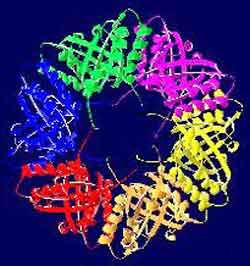New Protein Discovered By Hebrew University Researchers Holds Promise For Use In Medicine And Nanoscience

"Bagel-shaped" SP-1 protein
Researchers at the Hebrew University of Jerusalem have succeeded in discovering and isolating a new protein from the poplar tree with special structural and qualitative characteristics that could have consequences for development of future nanocapsules for drug delivery to cancer cells.
In addition to being obtained from plant tissue, the protein can now also be produced in large quantities as a recombinant protein in bacteria, making it highly available for medicinal or other applications.
Called SP-1, the protein has a nanometric, “bagel-shaped,” circular form and is extremely stable. It has been found to be capable of surviving contact with enzymes that break down proteins or exposure to extreme conditions such as boiling, excessive acidity, salinity, organic solvents or detergent solutions.
The research was conducted at the Hebrew University’s Faculty of Agricultural, Food and Environmental Quality Sciences in Rehovot by Prof. Arie Altman, head of the faculty’s Robert H. Smith Institute of Plant Sciences and Genetics in Agriculture, and Prof. Oded Shoseyov, with the participation of Dr. Wangxia Wang and Dr. Dan Pelah and the scientists of Fulcrum SP Ltd.: Dr. Amnon Wolf, Dr. Ira Marton and Dr. Yehonathan Pouny.
According to Profs. Altman and Shoseyov, the SP-1 protein serves to assist in creating a properly folded and functioning structure of other proteins within the plant’s cells. The SP-1 also has the ability to assemble itself into a structure composed of 12 identical units, making it exceptionally resistant to extreme conditions. These qualities are rarely found among proteins and make the SP-1 a promising candidate for a multiplicity of uses in developing medicinal applications in the rapidly growing field of nanobiotechnology.
SP-1 nanocapsules will be capable of delivering cell-destroying drugs specifically to certain types of solid cancer tumors. The protein’s tiny structure enables this carrier to penetrate specifically into tumors without harming healthy tissue and thus enhance the effectiveness of chemotherapy. This selective penetration is based on the fact that the blood vessels which feed tumors are considerably more porous than those reaching healthy cells. Therefore, the units of SP-1 carrying the drug would invade only the tumor-feeding blood vessels and not normal ones.
More recently, the three-dimensional structure of the protein was deciphered by x-ray crystallography in the laboratory of Dr. Orna Almog of Ben-Gurion University of the Negev. The research on this was published in the Journal of Biological Chemistry issue of December 2004, authored by Or Dgany of the Hebrew University, Ana Gonzales of Stanford University, Oshrat Sofer of Ben-Gurion University, Wangxia Wang of the Hebrew University, Gennady Zolotnitsky of the Technion, Amnon Wolf of Fulcrum, Yuval Shoham of the Technion, Arie Altman of the Hebrew University, Sharon G. Wolf of the Weizmann Institute, Oded Shoseyov of the Hebrew University and Orna Almog of Ben-Gurion University.
Professors Altman and Shoseyov are the scientific founders of the biotech start-up company Fulcrum SP Ltd. that is developing the SP-1 protein for cancer drug delivery and other applications.
For further information: Jerry Barach, Dept. of Media Relations, the Hebrew University, tel: 02-588-2904, or Orit Sulitzeanu, Hebrew University spokesperson, tel. 052-2608016.
Media Contact
More Information:
http://www.huji.ac.ilAll latest news from the category: Life Sciences and Chemistry
Articles and reports from the Life Sciences and chemistry area deal with applied and basic research into modern biology, chemistry and human medicine.
Valuable information can be found on a range of life sciences fields including bacteriology, biochemistry, bionics, bioinformatics, biophysics, biotechnology, genetics, geobotany, human biology, marine biology, microbiology, molecular biology, cellular biology, zoology, bioinorganic chemistry, microchemistry and environmental chemistry.
Newest articles

“Nanostitches” enable lighter and tougher composite materials
In research that may lead to next-generation airplanes and spacecraft, MIT engineers used carbon nanotubes to prevent cracking in multilayered composites. To save on fuel and reduce aircraft emissions, engineers…

Trash to treasure
Researchers turn metal waste into catalyst for hydrogen. Scientists have found a way to transform metal waste into a highly efficient catalyst to make hydrogen from water, a discovery that…

Real-time detection of infectious disease viruses
… by searching for molecular fingerprinting. A research team consisting of Professor Kyoung-Duck Park and Taeyoung Moon and Huitae Joo, PhD candidates, from the Department of Physics at Pohang University…





















